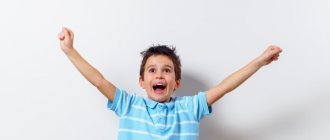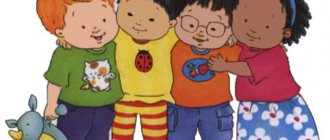Rhythmics for children: lesson in kindergarten
Rhythmics (rhythmic gymnastics) is a system of musical and rhythmic education, the purpose of which is to develop a sense of rhythm and coordination. Rhythmics is also called classes for children (usually preschool age), in which children learn to move to musical accompaniment, control their body, and develop attention and memory.
Rhythm for children is accompanied by fun, rhythmic music, so they perceive the classes positively, which, in turn, allows them to better assimilate the material.
A little history
Rhythmics, as a teaching method, was created at the beginning of the 20th century by a professor at the Geneva Conservatory, Emile Jacques-Dalcroze, who noticed that even the most careless students began to perceive and remember the rhythmic structure of music as soon as they began to move to the music. These observations laid the foundation for a system later called “rhythmic gymnastics.”
What does rhythm give?
In rhythmic classes, the child develops in many ways, acquiring a number of skills and abilities:
- The child’s physical fitness improves and coordination of movements is developed.
- the child learns the simplest dance movements, masters concepts such as tempo, rhythm, as well as the genre and nature of music
- the baby learns to adequately express and control his emotions, creative activity develops
- Rhythm in kindergarten is a good preparation for further music, dance, and sports classes.
- Rhythmic exercises provide excellent “peaceful” relaxation for hyperactive children
- rhythm for children helps to relax, teaches them to move freely, creates a feeling of joy
- Rhythmic lessons instill a love of music and develop a child’s musical taste
Differences between rhythmics and physical education or aerobics
There is certainly a lot in common between rhythmic gymnastics and regular physical education or aerobics - physical exercises in both are performed to music in a certain rhythm. But at the same time, different goals are pursued. Rhythm does not prioritize physical development, performance technique is not a priority, although this is also important.
The emphasis in rhythmic gymnastics is on developing coordination, the ability to listen and hear music, feel your body and control it freely, and, of course, develop a sense of rhythm.
When should I start exercising?
It is believed that it is optimal to start doing rhythmic gymnastics at 3-4 years old. By this age, coordination of movements is already quite developed. Rhythmics in kindergarten is usually carried out starting from the 2nd junior group. But early development centers also practice earlier starts.
After only a year, having barely learned to walk, toddlers are able to learn basic movements and perform them to music. The baby will not learn much, but he will acquire useful skills that will greatly facilitate his further general and musical development and learning.
Structure of a rhythm lesson
Rhythmic exercises include moving exercises that require sufficient space. Rhythm in kindergarten is carried out in a physical education or music room, usually accompanied by a piano (the use of soundtracks of children's songs and modern dance tunes will also be beneficial and diversify the lesson).
Children quickly get tired of monotonous activities, so the lesson is based on alternating small 5-10 minute blocks. First, physical warm-up is required (walking and running variations, simple exercises). Then comes the “main” active part, which requires maximum tension (both physical and intellectual). After which the children need rest - quiet exercises, preferably sitting on chairs. You can arrange complete “relaxation” with soothing music.
Next is the active part again, but on familiar material. At the end of the lesson, it’s good to have an outdoor game or start a mini-disco. Naturally, at all stages, including relaxation, material is used that is suitable for achieving the goals of rhythmic gymnastics.
Author – Sue Mac
Rhythmic, sports, aerobic complexes to music
Svetlana Masimova
Rhythmic, sports, aerobic complexes to music
Goal: To form a culture of movement, teach how to control your body and move to the rhythm of music, develop coordination of movements, fantasy and imagination.
The introductory part and warm-up during training sessions are most often carried out with music to lift the mood of children, so this block contains aerobic complexes and sports compositions performed to musical accompaniment.
Basic types of movements (walking, running); basic gymnastics exercises (ORU, drill); rhythmic gymnastics (exercises with a ball, hoop; wave-like movements of the body, arms, etc.); choreography (main positions of legs, arms); elements of pantomime are combined in a certain sequence and connected with music into a set of exercises - all this is called rhythmic gymnastics. The health-improving nature of gymnastics, the main means of which are sets of gymnastic exercises performed to rhythmic music, has long been proven.
All complexes performed to music are aimed at developing physical qualities, coordination abilities and functional capabilities of the body, nurturing expressiveness, and developing a culture of movements. Music creates a positive background for classes, helps children remember movements, and expressively convey their character. Phonograms of popular children's songs, modern hits, and classical music are used as musical accompaniment.
After performing rhythmic gymnastics in the main part, the child should show signs of only slight fatigue: slight redness of the face, calm expression, slight sweating; breathing is somewhat rapid, but remains even. The main task of these rhythmic complexes, lasting from 3 to 7 minutes, is to prepare children for the main load, without overloading them.
It is important to perform movements to music with a good mood, a smile, emotionally and contagiously, then the child will definitely want to repeat the movements of an adult and move to the beat of the music.
Sports composition with ball No. 1.
Musical composition “Hands up” by the group “Ottavan”
Introduction: Step on your toes, ball in front of your chest in both hands, elbows to the sides.
Chorus: throw the ball up and catch it - 2 times, 1-8 bounces in a circle with the ball in your hands in front of your chest - repeat twice.
1-8 march on toes, gently lift the ball from below with outstretched arms and smoothly lower it.
Verse 1: oh. s., ball in front of the chest, elbows to the sides. Stretch the ball to the right, 1 - foot on the toe to the right, 2 - take the IP, 3 - lift the ball up, 4 - take the IP, 5-6 the same to the left, 7 - lift the ball up, 8 - take the IP. Repeat 2 times.
IP - o. s., the ball at the top with outstretched arms. 1 – raise your right knee, touch it with the ball, 2 – IP, 3 – the same with the left, 4 – IP.
Chorus: same.
Verse 2: Jump with legs wide apart, ball in front of chest.
1 – tilt to the right, ball to the toe, 2 – IP, 3 – ball up with outstretched arms, 4 – IP, 5 – tilt to the left, 6 – IP, 7 – ball up with outstretched arms, 8 – IP. Repeat 3 times.
Chorus: same.
Verse 3: IP – kneeling, ball in front of chest. 1 - lean forward, touch the ball to the floor, 2 - IP. Repeat 6 times.
IP - the same. 1 – stretch the leg to the side on the toe, the ball up on outstretched arms, 2 – IP, 3 – extend the left leg to the side on the toe, 4 – IP. Repeat 4 times.
Chorus: same.
Rhythmic composition “Cheerful Baby”
Music by K. Orbakaite “Sponges with a bow”
Introduction: feet together, hands on the belt, alternately step from the toe of one foot to the other.
Lose: hands in front of the chest, palms forward, elbows down; right foot forward onto the toe, then left - 4 times on each leg.
Verse 1: step to the side, “tease” with body rotation - 4 times in each direction.
Chorus: sit down, hands in front of the chest, stand, foot forward on the heel - 2 times on each leg.
Feet together, hands in front of the chest, bend slightly to the right, then to the left, raising the shoulder.
Losing: “okay” - half squat, clap your hands, stand up, bring your right arm straight at the elbow, palm forward, left in front of the chest; repeat with the left hand – 4 times.
Verse 2: step to the side, lock your hands, rattle like a rattle - 2 times in each direction.
Chorus: same.
Verse 3: lunge forward, hands behind your head, make “horns” - 4 times.
Chorus: bend to the sides, hands to shoulders, fingers spread - 2 times
jumping around its axis, hands to shoulders, fingers spread.
Sports and musical composition "Ali Baba"
Loss:
1. IP – sitting cross-legged, hands in front of you, elbows on your knees, palms looking up in a “boat” position. 1-extend your arms smoothly to the sides, 2-raise your arms up through the sides and fold them into a boat, 3-extend your arms smoothly to the sides, 4-IP.
Verse:
2. IP - sitting, arms supported behind you, one leg extended, toes pulled, second leg slightly bent at the knee, placed on the toes. 1-2 – move the bent leg over the straight leg, touch the toe to the floor, slowly and smoothly. 3-4 – the same quickly. 5-8 - on the other leg.
Loss:
3. IP – sitting position, legs bent at the knees. 1 – lift your hips off the floor as high as possible, 2-IP.
Verse:
4. IP - sitting, legs spread apart, arms with palms up, to the sides, slightly bent at the elbows. 1-4 – reach for the right leg with your hands, 5-8 – take IP. Repeat with the other leg.
5. IP - sitting, legs apart, arms with palms up, to the sides, slightly bent at the elbows. 1-4 – reach for the right leg with your hands, 5-8 – take the IP and move your chin forward 4 times. Repeat with the other leg.
Chorus:
6. Individual entrepreneur – the same. 1 – bring your arms in front of you and at the same time bring your straight legs together, 2-IP.
Loss:
7. IP – emphasis on legs bent at the knees and arms straight, belly up “spider”. 1-4 – rotation around its axis to the right, 5-8 – to the left.
Chorus:
8. IP – crouching emphasis. 1-jump legs apart straight at the knees, 2-IP.
Loss:
9. IP – Fr. p., 1-4 – bend forward and take four steps with your arms to the “plank” position, lie on the floor, hands resting near your shoulders, 5-12 – raise the shoulder girdle up, straightening your arms completely, look up, 13-16 – four steps with your hands back and take IP.
10. Repeat exercises No. 1.
Rhythmic composition “Karapuz”
Music HOLLY DOLLY “Dolly song”
Exit by jumping with arms swinging to the sides and forming three columns.
1. Naughty people. I. p. - feet shoulder-width apart, arms to the sides, elbows bent upward, fingers spread wide apart.
Execution technique. Rocking to the sides with a tilt of the head and a half-squat, bending your knees.
2. Toddlers. I. p. - heels together, toes apart, cheeks puffed out, index fingers at the cheeks.
Spring.
3. Horses. I. p. - lunge, arms extended forward.
Execution technique. Spring, imitation of horse riding. Then turn around and spring again.
4. Flashlights. I. p. - stand on one knee, arms to the sides.
Execution technique. Dance with one foot (the one in front). The arms, with the hands vibrating, rise up and fall to the sides.
5. Scissors. I. p. - legs slightly raised from the floor, arms extended forward.
Execution technique. Spread your arms and legs apart and connect them crosswise.
6. Airplane. I. p. lying on his stomach, arms extended forward.
Execution technique. Bend over, lifting your head, arms and legs from the floor.
7. Basket. I. p. lying on his stomach.
Execution technique. Take your legs with your hands and lift them up. Tilt your head to the sides to the beat of the music.
8. Swallow. I. p. - emphasis on the hands and knees.
Execution technique. Alternately raise your straight leg and head up.
9. Parsley. I. p. sitting, legs wide apart, arms bent at the elbows to the sides and spread apart.
Execution technique. Bend to the side with emphasis on the lo-| cat, the other hand on the belt, the lower leg is straight, and the upper leg is bent;; kick and straighten the knee. Then move to the other elbow.
10. Camel. I. p. - stand on your knees, feet resting on your toes, fingers.
Execution technique. Bend back, place your hands on the heels of your feet. Turn your head to the sides to the beat of the music.
11. Rocket. I. p. - kneeling position.
Execution technique. Jump, moving from and. n. on the soles of the feet.
12. Mowgli. Jumping with arms and legs spread to the sides at the highest point of flight.
For the chorus: jumping and moving in a circle.
13. Pinocchio. Jumps with imitation of Pinocchio (hands turned towards the nose).
14. Hare. Jumps with imitation of hare ears (hands on the top of the head, elbows to the sides).
15. Goat. Jumps with imitation of goat horns (index fingers on the top of the head).
16. Pinwheel. Jumping with a spin.
At the end, form three columns again in leaps. When finished, spread your arms and legs to the sides.
Sports composition with ball
X-Mode “In the Animal World”
1. IP – standing in o. With. ball in right hand. 1 - raise your hands up, transfer the ball to your left hand, 2 - lower, 3 - raise your hands up, transfer the ball to your right hand, 4 - IP.
2. IP - standing in o. s., ball in right hand. 1 - sit down, transfer the ball to your left hand, 2 - IP, 3 - transfer the ball to your right hand, 4 - IP.
3. IP – standing, legs apart, arms to the sides, ball in the right hand. 1 - tilt to the right, with your left hand reach over your head with your right hand, take the ball in your left hand, 2 - straighten up with the ball in your left hand, 3 - tilt to the left, take the ball with your right, 4 - IP.
4. IP - wide stance with legs apart, ball in the right, arms to the sides. 1- tilt to the right leg, transfer the ball to the left under the foot, 2- IP, ball in the left, 3- tilt to the left, transfer the ball to the right, 4- IP.
5. IP – hitting the ball on the floor and catching it with both hands.
6. IP - throwing the ball up and catching it with both hands.
7. IP – sitting with your feet apart, arms supported behind you, ball on the floor in the center at the level of your feet. 1-bring your legs straight, toes extended, touch the ball, 2-IP.
8. Jumping on the right, ball in the right hand - 10 times, jumping on the left, ball in the left - 10 times, walking in place.
Outdoor switchgear without objects to music
Music "Macarena"
Losing: Bend to the sides with a soft squat, arms bent at the elbows, raised up, fingers apart.
Verse: Jump on one leg, the other is bent at the knee, take out the opposite elbow (2 times).
Losing: Jumping with legs thrown forward, with cross movements of the arms, pulling the opposite hand to the knee.
Verse: Jump in a circle one after another, arms up, to the sides.
Losing: Dance moves (twist, standing on all fours, “twirling your tail.”
Movement in and out of the circle. Dance movements at the request of children.
Outdoor switchgear on fitball
Music "OK" Ottawa
Landing on the ball: straight back, foot on the floor, angle at the knee joint at least 90 degrees
Verse: IP - sitting on a fitball, hands to shoulders. 1-3 – circular movements of arms bent at the elbows; 4- return to IP. (Repeat 6 times).
IP - sitting on a fitball, arms up, right leg to the right. 1-2 – tilt to the right towards the leg; 3-4 – return to IP. Same to the left. (Repeat 3-4 times in each direction).
Loss: IP - lying on a fitball on your stomach, hands on the floor. 1- lift your right leg up; 2- return to IP; 3-4 – the same with the left foot. (Repeat 3-4 times in each direction).
IP - sitting on a fitball, hold onto it with your hands at the side. 1-4 – step your feet forward and move to a lying position on the fitball; 5-8 – return to IP. (Repeat 6 times).
Verse: IP - lying on your back on the floor, straight legs on a fitball. 1-2 – raise the pelvis from the floor, resting your feet on the fitball; 3-4 – return to IP. (Repeat 6-8 times).
IP – sitting on a fitball, hands behind your head. 1- tilt to the right, touch your right thigh with your elbow; 2 – return to IP; 3-4 - in the other direction. (Repeat 3-4 times in each direction).
Losing: Jumping with a fitball in your hands, at the end lie on your stomach on the fitball and relax.


